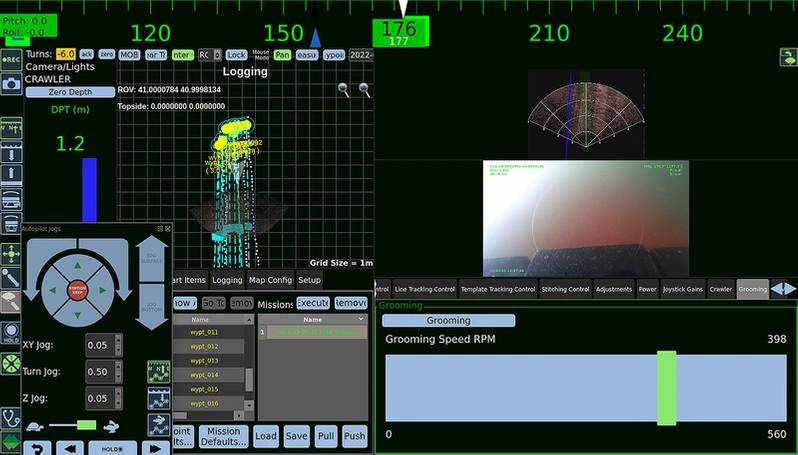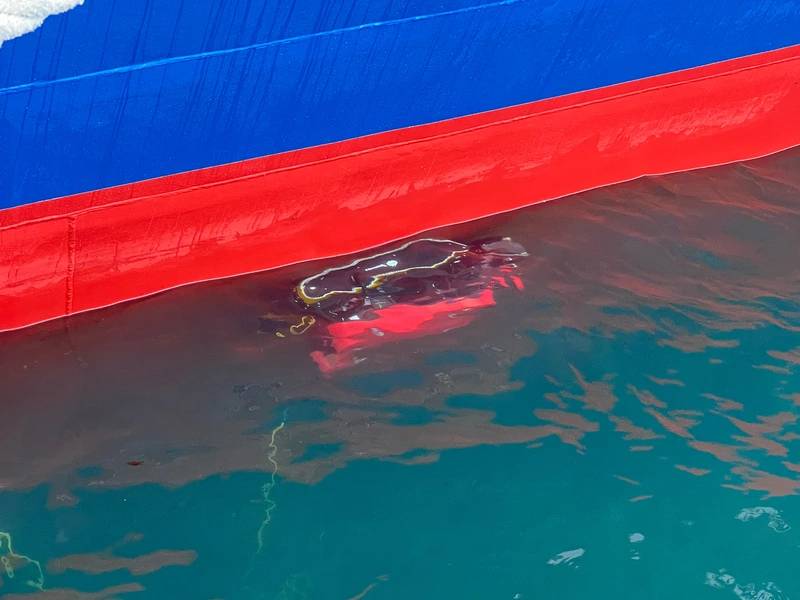Armach Robotics Set to Take the Pole Position on Ship Hull Maintenance, Intelligence
Melding advanced software, intelligence, robotics and navigation, Armach Robotics – a spinoff of Greensea Systems – leads a step change in ship hull cleaning and maintenance with its Robotics as a Service model. Ben Kinnaman, the CEO of Greensea Systems, explains.
- Ben, to start us off, please give us a background on Armach Robotics? Where did the idea come from and where are we today?
Greensea Systems is a software company, well-known for our software platform on ocean robotics. We're also well-known for our unique navigation and autonomy solutions. A few years ago we started a program with the Office of Naval Research (ONR) developing a very accurate navigation solution for robots transiting on a ship hull for the purposes of proactive in-water cleaning the hulls. ONR was a pioneer in the development of proactive in-water grooming of ship hulls back in the early to mid-2000s.
This requires the insurance of a 100% coverage of the hulls, and to be really effective and efficient, it needs to be a robotic solution; and you can't field an autonomous robotic solution unless you have an accurate navigation solution. We have an accurate navigation technology (created working in partnership over many years with ONR). The more we began exploring proactive in-water cleaning, the more opportunity we saw.
Greensea is not a robot manufacturer. Greensea is also not a service provider. Greensea develops software solutions, partnering with other manufacturers that build robots to generate a path to market. When it came to proactive in-water cleaning and this robotic solution, we couldn't find a manufacturer or a vehicle partner that was ready to achieve the level of potential that we saw. So, we spun the technology out of Greensea into a new entity called Armach Robotics, which is going forward with a complete, proactive in-water cleaning solution for ships and ship hulls based on autonomy, data fusion and intelligence.
 "What we are offering ship owners is a very simple product: a constantly clean hull for a basic subscription fee," said Ben Kinnaman, CEO, Greensea Systems, in discussing the rationale behind the creation of Armach Robotics.
"What we are offering ship owners is a very simple product: a constantly clean hull for a basic subscription fee," said Ben Kinnaman, CEO, Greensea Systems, in discussing the rationale behind the creation of Armach Robotics.
- So is Armach Robotics a product company, a service company, or both?
Neither, actually. This is a Robot as a Service (RaaS) company. We are providing resident vehicles to ships, resident vehicles to ports and harbors and vehicles to establish service providers on a monthly subscription basis. What we are offering ship owners is a very simple product: a constantly clean hull for a basic subscription fee. But they also receive intelligence on the hull. After we clean we're able to produce a data product that is a geo-referenced and accurate. So, we are not a robot provider. We're not a service provider. We are a clean hull provider and we do that through a subscription method.
- Discuss what you see as the major technical highlights of your hull cleaning robotic system? What is it designed to do that others cannot?
It's all about navigation, because if you don't have navigation, you don't have anything. The lack of navigation (in current solutions) result in undo wear-and-tear on coatings, because its overworking the coating, using very large systems or cleaning reactively, not proactively. With an accurate navigation solution, we can enable a small, efficient robot that's going to cover 100% of the hull. It can a fully autonomous, so we get the diver out of the water.
And if you have an accurate navigation solution, you also have a data product. There are a lot of solutions in the field claiming hull survey, thickness survey, NDT coating surveys, but there's no navigation solution. So, I really question the quality of the data if you don't know where the data was taken on the ship hull. So, it all comes down to navigation. We approach this problem entirely from a navigation perspective. We didn't approach it from a cleaning perspective. We didn't approach it from a machine or a robot perspective. We came at it in solving the absolute fundamental enabling problem in this industry and that is navigation. If you know where the robot is on the hull, you can assure 100% coverage.
 "It's all about navigation, because if you don't have navigation, you don't have anything." Photo courtesy Armach Robotics
"It's all about navigation, because if you don't have navigation, you don't have anything." Photo courtesy Armach Robotics
- As you know, ship owners must see a significant ROI to invest in a new solution. What is the value proposition for the Armach Robotics solution?
Without a doubt, anyone adopting this is going to realize five very clear value propositions. The first is fuel savings. If you have a clean hull, you have less drag going through the water, it takes less fuel to move that ship. You're going to have a very clear fuel savings benefit, with estimates ranging between 10-20% of fuel savings by maintaining a clean hull.
The second is operational efficiency. If you can clean on your terms, and if you can maintain your hull on your terms, you are going to realize increased operational efficiency. You can clean anywhere, anytime you can maintain your hull and you know proactively the condition of your hull and not reactively. So, the second clear value proposition is just simple, operational efficiency. Maintenance on your terms.
The third is maintenance cost savings. If you're maintaining the hull and cleaning the hull continuously and not reactively, you're going to save money on those maintenance costs. You're going to extend the life of your coating. You're going to extend the period between dry dockings. You're going to be able to instigate proactive maintenance versus reactive maintenance.
The fourth is fleet readiness. If that ship hull is clean and if the process of maintaining that hull is done within the normal day-to-day cycle and transit cycle of the ship, the ship is going to be ready for deployment more often.
The fifth, final and perhaps most significant is the environmental benefits. With a clean hull, we require less fuel to push the ship to the water, which means reduced carbon emissions.
- The Armach Robotics mantra is “the future of ship husbandry is intelligence.” What, exactly, does that mean?
We maintain ship hulls today almost exactly like we maintained ship hulls when we first started sailing the oceans: we coat them with a toxic substance, we put divers in the water to scrape them clean and when the coating wears out, we haul them out and re-coat them. There's a more intelligent way of maintaining hulls. By applying intelligence, by applying navigation, by applying autonomy, by applying data fusion and the use of robotics, we can maintain these hulls in a more efficient and more productive manner. So, we're using brains over brawn here.
And because we have navigation, when our vehicles are transiting the hull and maintaining and cleaning the hull, we're constantly mapping the hull, building a real-time map using high-resolution sonar and video. That map becomes a data product, (allowing shipowners to) respond to wear-and-tear (instead of) responding to catastrophes.
 "We're constantly mapping the hull, building a real-time map using high-resolution sonar and video. That map becomes a data product, (allowing shipowners to) respond to wear-and-tear (instead of) responding to catastrophes," said Kinnaman
"We're constantly mapping the hull, building a real-time map using high-resolution sonar and video. That map becomes a data product, (allowing shipowners to) respond to wear-and-tear (instead of) responding to catastrophes," said Kinnaman
- Can you tell us a little bit about the team behind the Armach Robotics name?
Team and culture is everything to me. It's critical to the success of a company, it's critical to our enjoyment of our jobs. I’ve been in the industry a long time, so when I founded Armach, I had the opportunity to hand select our leadership team. Our VP of operations is John Dunn, who I’ve known since 2012; John solves problems, he outworks things. Rob Howard has been in the industry a long time and I've always thought the world of him as sales and business development. He knows everybody in the industry; he knows the trends in the industry. He knows the industry from the robotics side, so, I brought him in as Vice President of Growth and Strategy.
James Truman is our VP of Engineering. James and I have worked together since the early to mid-2000s, he and I were in graduate school at Johns Hopkins together. He was a chief engineer at Teledyne Webb, and James and I have built a lot of robots almost two decades. And when we started doing the hull robotics segment at Greensea and developing this technology, I brought James into Greensea to lead that technical development. When I founded Armach, James moved over to Armach as VP of Engineering.
We brought in Alex Kern as Director of Sales and Marketing following a solid career at Hydroid; he knows how to sell internationally and brings a lot of enthusiasm and energy. Karl Lander is the senior program manager (after a stint) at Greensea for five years. He was the program manager that led the hull navigation and technology development. He was interfaced ONR. He is a retired coast guard officer with a lot of experience in engineering and ship yard management. We also have Harrison Gardner as a robotics engineer at Armach. Harrison had been working at FIT, which was the academic pioneer of proactive in water cleaning.
- Having founded another company, what excites you most about the Armach Robotics potential?
The number one motivator for me is the ability to provide a meaningful change in the impact shipping has on the environment.
- I know that you're just getting started, but what's the vision for the company? Where do you see this progressing in about five years?
We're at the very beginning of realizing the benefits of proactive in-water cleaning and survey. The reactive methods of maintaining ship hulls is changing, and I think that we're seeing decisions that are going to start being made by data and by intelligence versus reaction. Armach is well-positioned to be the leader of that paradigm shift in industry. I think five years from now, we are going to see proactive, in-water cleaning as a default method of maintaining hulls. I think that ships engineers and stakeholders and asset owners are going to be maintaining and making decisions based on the data.
And five years from now, Armach will be the leader in this concept, will be the leader in hull data, we will be the leader of in-water proactive and water cleaning.
Watch the full interview with Ben Kinnaman on Maritime Reporter TV regarding the creation of Armach Robotics:
















